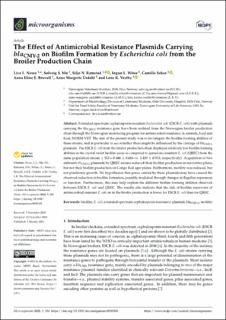The effect of antimicrobial resistance plasmids carrying BlaCMY-2 on biofilm formation by escherichia coli from the broiler production chain
Nesse, Live Lingaas; Mo, Solveig Sølverød; Ramstad, Silje; Witsø, Ingun Lund; Sekse, Camilla; Bruvoll, Anna; Urdahl, Anne Margrete; Vestby, Lene Karine
Peer reviewed, Journal article
Published version

View/
Date
2021Metadata
Show full item recordCollections
Abstract
Extended-spectrum cephalosporin-resistant Escherichia coli (ESCR E. coli) with plasmids carrying the blaCMY-2 resistance gene have been isolated from the Norwegian broiler production chain through the Norwegian monitoring program for antimicrobial resistance in animals, food and feed, NORM-VET. The aim of the present study was to investigate the biofilm forming abilities of these strains, and in particular to see whether these might be influenced by the carriage of blaCMY-2 plasmids. The ESCR E. coli from the broiler production chain displayed relatively low biofilm forming abilities in the crystal violet biofilm assay as compared to quinolone-resistant E. coli (QREC) from the same population (mean ± SD = 0.686 ± 0.686 vs. 1.439 ± 0.933, respectively). Acquisition of two different blaCMY-2 plasmids by QREC strains reduced their biofilm production in microtiter plates, but not their biofilm production on Congo Red agar plates. Furthermore, motility was reduced, but not planktonic growth. We hypothesize that genes carried by these plasmids may have caused the observed reduction in biofilm formation, possibly mediated through changes in flagellar expression or function. Furthermore, this may help explain the different biofilm forming abilities observed between ESCR E. coli and QREC. The results also indicate that the risk of biofilm reservoirs of antimicrobial resistant E. coli on in the broiler production is lower for ESCR E. coli than for QREC.